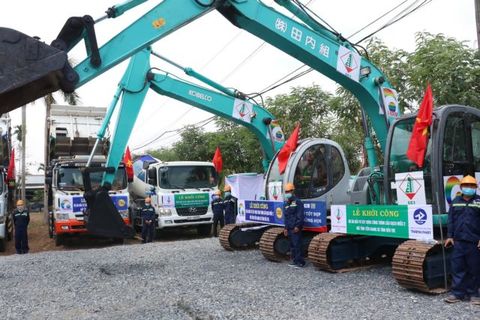
Crossing the Tien River and connecting Tien Giang and Ben Tre provinces, construction on the cable-stayed Rach Mieu No 2 Bridge started in March. — VNA/VNS Photo Huynh Phuc Hau
A number of transport projects have been proposed to enhance regional linkages and boost socio-economic development in the Cuu Long (Mekong) Delta.
The Ministry of Transport recently sent a document to the Ministry of Planning and Investment and the Ministry of Finance to propose the implementation of a project to upgrade and renovate three national highways, No. 53, No.62 and 91B, in the delta with a total investment of more than VND7 trillion (US$294 million), funded by a loan from the World Bank.
The Ministry of Transport has recently approved 12 component projects of the North-South Expressway project in the 2021-25 period, with a total length of 723.7 kilometres, including a 110.9km section between Can Tho city and Ca Mau Province.
Lam Minh Thanh, chairman of Kien Giang Province’s People's Committee, said he has recently signed and promulgated a master plan for the province’s socio-economic infrastructure development, in which, the most important factor is traffic.
“We have determined that it is essential to improve traffic connectivity with Can Tho city, and An Giang and Hau Giang provinces,” he said.
The province plans to upgrade the Lo Te - Rach Soi Expressway, and the coastal corridor connecting Ca Mau Province, and the N1 Road connecting An Giang Province.
According to An Giang Province’s People's Committee, the Government has approved investment to complete the planned important highways of Can Tho - Ca Mau, Chau Doc - Can Tho - Soc Trang - Tran De and My An - Cao Lanh - Lo Te - Rach Gia by 2025.
The new highways are expected to meet the development needs and raise the position of the delta region, including An Giang and the Long Xuyen Quadrangle.
Long An Province has been mobilising resources to invest in its transport infrastructure, part of the national road network development plan for the 2021-30 period, including construction of a 60km-long axis road connecting HCM City with Long An and Tien Giang provinces.
The road, to be named National Highway 50B, will help to reduce traffic pressure on National Highway No. 1A, National Highway No. 50, N2 Highway, and the HCM City - Trung Luong Expressway, strengthen trade connections between the delta provinces and HCM City.
To reduce the current overload on the existing Rach Mieu Bridge, Ben Tre Province began construction of the Rach Mieu 2 Bridge in March and is expected to put it into operation in 2025.
With a total investment of nearly VND5.2 trillion ($218.3 million), the Rach Mieu 2 Bridge will be 3.8 kilometres upstream from the existing Rach Mieu Bridge.
Ben Tre and Vinh Long provinces have agreed on a plan to build Dinh Khao Bridge crossing Co Chien River and passing through Phu Da and Phu Binh islets in Ben Tre Province.
The bridge will have a total length of 11.31km, starting at National Highway No. 53 in Vinh Long and ending at the intersection with National Highway No. 57 in Ben Tre.
Reducing logistics costs
Tran Quoc Dung, general director of Kien Hung Seafood Export Joint Stock Company, said the logistics costs are still relatively high in some provinces in the delta such as Ca Mau and Kien Giang.
Transporting a 20-foot container from Kien Giang Province to the export ports in HCM City costs around VND8 million ($335), which is about 15 per cent higher than the transportation cost in other provinces such as Can Tho City and Tien Giang Province.
Therefore, if the investment in highways throughout the delta is soon completed, it will not only reduce logistics costs for enterprises but also improve investment attraction in new projects and create on-the-spot jobs for thousands of labourers, Dung said.
Bui Ngoc Suong, former chairman of Kien Giang Province’s People's Committee, said large cities in the southeast region such as HCM City, and Ba Ria-Vung Tau, Binh Duong and Dong Nai provinces are overloaded by millions of migrant workers mostly from the Mekong Delta.
Meanwhile, the provinces and cities in the delta still have many industrial zones and industrial clusters with great potential, he said.
For example, Kien Giang, Ca Mau, An Giang and Dong Thap provinces have industrial clusters for agro-fishery processing for export, construction material manufacturing, food processing, and rice milling. However, they have not attracted many investors yet.
“If the traffic is convenient, enterprises will definitely pour capital into the delta. Millions of workers will not have to work in other provinces," he said.
According to the Foreign Investment Agency under the Ministry of Planning and Investment, the Mekong Delta has the lowest number of foreign investment projects across the country because of poor transport infrastructure, except for Long An Province because it is adjacent to HCMC.
The delta was home to 1,825 valid foreign-invested projects, with a total registered investment capital of nearly US$33.5 billion, accounting for 8.4 per cent of the total registered investment capital of the country. — VNS